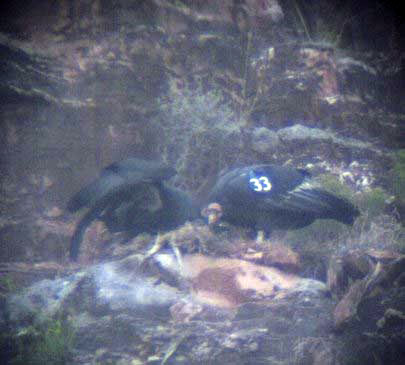|

NEWS RELEASE For Release: December 4, 2008 Contacts: Jeff Humphrey, U.S. Fish and Wildlife Service (602) 242-0210 x222 Bill Heinrich, The Peregrine Fund (208) 362-3716 Two More California Condor Chicks Flying Free at Grand Canyon Grand Canyon, AZ. – The Grand Canyon—a vast region of gorges and craggy spires so immense that it far exceeds the boundaries of any human definition of a park—is not just a spectacular landscape, but an ecosystem filled with prime wildlife habitat. As such, it is an important geographic focal point for the recovery of the endangered California condor. This year, two wild chicks hatched and fledged in Grand Canyon National Park, bringing the Arizona population close to 70 and the word’s total population (captive and free-flying) to well over 320. While 70 and 320 may seem like dishearteningly small numbers, as recently as 1982, the world population was down to just 22 birds; and by 1987, all of the world’s remaining California condors were in captivity. Today, about half of the world’s condors are free-flying; and since recovery efforts began, nine chicks, including 2008’s two Grand Canyon chicks, have been hatched and fledged in the wild in Arizona. California condors are North America’s largest flying land birds with a wing span of over nine feet. They are primarily soarers, sometimes going for miles without a single flap of their wings. As a result, they prefer to live in areas with mountains, gorges, and hillsides, which create updrafts and provide favorable soaring conditions. Condors also require caves, ledges or large tree cavities for nesting. The Grand Canyon area would seem to be perfect condor habitat, and evidence indicates that the birds did nest in the canyon for thousands of years. However, as climates changed after the last ice age and, more recently, as human impacts increased, the condor’s range shifted and numbers dwindled. The last wild condor in Arizona was sighted just south of the Grand Canyon in 1924. It was not until reintroduction in northern Arizona began in 1996 that condors were once again seen flying over the Grand Canyon; and in 2003, Arizona’s first "wild-hatched" chick in over 100 years hatched in Grand Canyon National Park. The parents of that historic chick, condors 127F and 123M, were one of only two condor pairs to successfully hatch and fledge a chick in Arizona this year. Their chick, 472, was seen taking short flights at the canyon on October 16. The second chick, 476, belongs to first time parents 133F and 187M. Its mother, condor 133F, has her own place in condor history. She is the last remaining bird from the initial Arizona condor release in 1996. Her chick was seen taking its first short flights in September. Though it is further from the brink of extinction than it was a quarter century ago, the California condor’s long-term survival is far from assured. The birds are normally long-lived, and don’t reach maturity until they are about six years of age. As a result, they are not prolific reproducers, usually only tending one egg every other year. Yet, they are regularly faced with threats such as lead poisoning from spent ammunition, predation, and accidental and intentional shooting. The recovery plan for the California condor calls for the maintenance of three distinct condor populations—two in the wild and one in captivity—each having at least 150 members and including at least 15 breeding pairs of birds. There is a long way to go to reach that goal; but recovery efforts by committed organizations continue. The Peregrine Fund, Arizona Game and Fish Department, Utah Division of Wildlife Resources, Bureau of Land Management, National Park Service and U.S. Fish and Wildlife Service are only a few of the many organizations that have banded together to work on condor recovery. Each year, more and more people from around the world come to Grand Canyon National Park hoping, while they are here, to observe the majestic flight of the California condor. Here, rangers, wildlife biologists and volunteers have an opportunity to not only learn about condors, but to share what they are learning about the birds’ unique qualities, their needs and what each of us can do to help protect them. Here, the spectacular landscape has become more than just ecosystem and habitat, it has become home to one of the world’s rarest birds, classroom to those who wish to learn about them, and a place where we can all learn to hope when two more California condor chicks hatch and fledge in the wild. To learn more about California condors, the on-going recovery effort and what you can do, please visit the Arizona Game and Fish Department on line at www.azgfd.gov/condor or the Peregrine Fund t http://www.peregrinefund.org/conserve_category.asp?category=California%20Condor%20Restoration To learn more about California condors in Grand Canyon National Park, please visit the park’s web site at www.nps.gov/grca/naturescience/california-condors.htm |
Last updated: December 20, 2017
